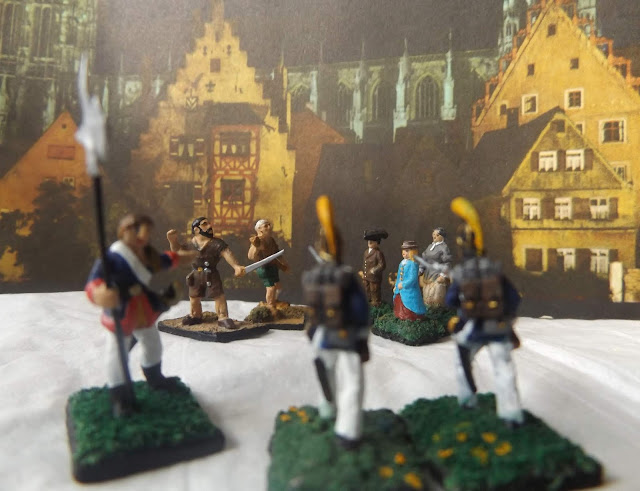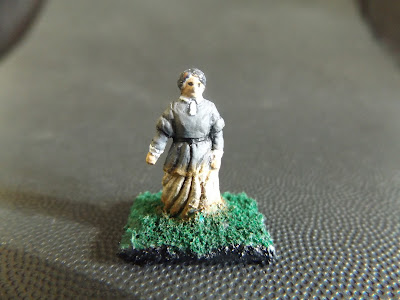"Lágrimas de plomo" - "tears of lead"
The Motto of Las Minervas
In the history of Oronegro there's one unit who stands out above the rest, indeed they do so quite literally. The 8th regiment of line, Las Minervas, from La Tierra del Diablo was one of the first units to be formalised during the founding of Oronegro's standing army. As with all these early regiments they were recruited from and garrisoned in one of Oronegro's major settlements, in this case La Tierra del Diablo which contests with La Ley the honour of being the first settlement established in Oronegro. La Tierra del Diablo is unlike any other settlement in Oronegro founded by witches, heretics and pagans the settlement is home to a few mysteries and people whisper of unspeakable horrors that stalk the streets on dark and misty nights.
 |
| Las Minervas may be unusual in many ways but too often foes have mistaken their apparent novelty for incompetence a mistake they rarely get to make twice. |
Such stories and the aversion to the religious beliefs and practises of La Tierra's inhabitants have been the source of much mistrust towards the settlement from Oronegro's other inhabitants. This mistrust is returned as it was known that the inquisition, ostensibly outlawed by the constitution was given free reign in many of Oronegro's cities. In this climate of mutual loathing and suspicion it should come as no surprise that when the time came for the formalisation of Oronegro's armed forces there were few volunteers from the militia of La Tierra del Diablo to establish a regiment. There was one exception however, the followers of Greco-Roman paganism, specifically those devoted to the goddess Minerva. According to the popular account it was an oracle who foretold how it would be the daughters of Minerva who would save the settlement in a time of great calamity. So it was that the daughters of La Tierra stood up and announced themselves as Oronegro's 8th regiment, Las Minervas, the daughters of Minerva.
Las Minervas occupied an odd position withing the Oronegrean military. On paper they were a line regiment, which normally would be composed of 1000 troops divided into two cohorts of 500 infantry, officers and other attached forces. Except Las Minervas never reached that size during their history. At their largest they numbered around 500, the size of a cohort. However, the most usually fielded for combat (in campaign that is, most remained behind to defend La Tierra, as per the prophesy) was around 120-150. Due to their small size they operated more as a century than a regiment. Numbers, however, are not everything and despite their small size in numbers they were exceptional in many ways. The first and immediately notable was their height. At an average height of 194cm or 6'4" they towered over their fellow soldiers. Indeed they were so well known for their height that Frederick William I of Prussia became obsessed with them, trying many times to kidnap the women of the regiment. He was unsuccessful, due to both the strength of the women who repeatedly fought off his hired thugs and by prudent measures put in place to guard the women when they were off duty.
 |
| Rosa Alexandra Minervista, the commander of Las Minervas, devoted to her sisters whom she commands and to her goddess. She is highly respected by both her fellow officers and by her foes. |
Unwanted attention of Prussian kings were not the only threats the unit faced. Their daring and bravery in battle along with their skill (and the terror they caused amongst their foes) brought the admiration of their fellow soldiers. They were known to stand firm even as the rest of the line crumbled around them. Officers from Las Minervas, all of them women, were known to become some of Oronegro's finest generals, the tales of whom should be familiar to any student of Oronegrean history. One of these women, Rosa Alexandra Minervista (Minervista being the name taken by those who fully devoted their lives to the goddess) would lead Las Minervas to reach the pinnacle of their prestige. Their achievements during her command will be accounted elsewhere. For now we shall conclude this history with a discussion of their final years.
 |
| Las Minervas were often paraded before visiting dignitaries. Many of whom were deeply impressed by these tall women. Their enemies were equally impressed by their skill in combat |
It can be said that Las Minervas represented the best of Oronegro's pre-independence culture. While the tolerance and acceptance of that society existed more on the pages of the constitution than in practice there were some instances of genuine progressive policy. The approval of the 8th Regiment, Las Minervas, into the ranks of the fledgling Oronegrean army was one of those. Where elsewhere women were being murdered on suspicion of witchcraft or being shunned for pursuing tasks seen as too masculine, these openly pagan women became the pride of a nation! A nation however, that was changing and lamentably was becoming less open to them.
During the civil war of the 1860s they fought the last of their battles. Taking the side of the Royal/anti-independence forces they stood against the nationalists who wanted to impose a more conservative order on Oronegro. They fought bravely until the end. Refusing to surrender they died defending La Tierra del Diablo. It was during this fight that they managed to kill Don Juan de San Antonio, leader of the nationalist forces who had sworn to wipe the heretical town from the face of the Earth. In so doing it was said that they did indeed fulfill the prophecy, for the new commander a man of a more gentle nature would not allow the civilians of La Tierra to come to harm. The victorious nationalist forces celebrated the rebirth of the nation. However, this new nation was not as welcoming as the old. There was no place in it for women soldiers, nor pagan soldiers. As such Las Minervas was formally disbanded and would not be officially reconstituted until the end of the Second Oronegrean Civil War in the mid 21st century.





















